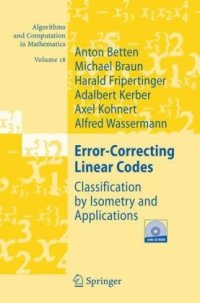
Ebook: Error-Correcting Linear Codes: Classification by Isometry and Applications
- Genre: Computers // Algorithms and Data Structures
- Tags: Algebra, Algorithms, Coding and Information Theory, Signal Image and Speech Processing, Combinatorics
- Series: Algorithms and Computation in Mathematics 18
- Year: 2006
- Publisher: Springer-Verlag Berlin Heidelberg
- City: Berlin; New York
- Edition: 1
- Language: English
- pdf
This text offers a thorough introduction to the mathematical concepts behind the theory of error-correcting linear codes. Care is taken to introduce the necessary algebraic concepts, for instance the theory of finite fields, the polynomial rings over such fields and the ubiquitous concept of group actions that allows the classification of codes by isometry. The book provides in-depth coverage of important topics like cyclic codes and the coding theory used in compact disc players.
The final four chapters cover advanced and algorithmic topics like the classification of linear codes by isometry, the enumeration of isometry classes, random generation of codes, the use of lattice basis reduction to compute minimum distances, the explicit construction of codes with given parameters, as well as the systematic evaluation of representatives of all isometry classes of codes. Up until now, these advanced topics have only been covered in research papers.
The present book provides access to these results at a level which is suitable for graduate students of mathematics, computer science and engineering as well as for researchers.
This text offers an introduction to error-correcting linear codes for graduate students in mathematics, computer science and engineering and researchers. The book differs from other standard texts in its emphasis on the classification of codes by means of isometry classes. The relevant algebraic concepts like finite fields and group actions are developed rigorously. Cyclic codes are discussed in great detail, as well as their application in CD players. In the last four chapters these isometry classes are enumerated, and representatives are constructed algorithmically with or without a prescribed automorphism group. Furthermore, lattice basis reduction is presented as a tool for computing generator matrices and the minimum distance of codes. The attached CD provides access to generator matrices of more than 70000 nonisometric optimal codes, covering all optimal codes for a given set of code parameters. It also contains software for evaluating minimum distances, weight enumerators, and for the construction of codes.